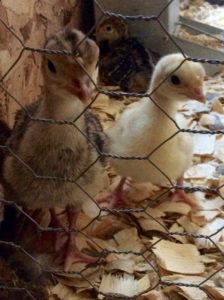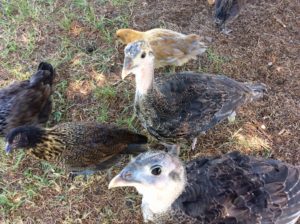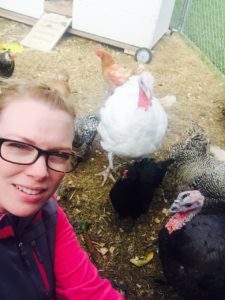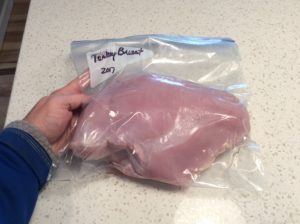Back in June of this year my husband and I purchased 3 turkeys from the local feed store. At $12 per bird, we were pretty protective of the little buggers. As my better-half finally gave in and agreed to raise a few turkeys, he received the honor of naming the birds. Quite creatively he dubbed them Thanksgiving, Christmas, and Easter.

Upon first glance, you could tell the turkeys apart from the Auracana chicks purchased at the same time. We understood their growth would quickly outpace their chicken counterparts but decided to raise them no differently. They spent their time with the rest of the flock and integrated well.
From the beginning, the turkeys were very curious and voracious eaters. Feeding time was always an interest to them and treats of mealworms were a favorite. They stayed close to the food while free-ranging and came back to the coop each night with the rest of the flock. They served as great protectors of the decidedly smaller Auracanas within their age group.

As they grew larger, the turkeys and I began to talk to one another. They would come running, calling “Turk Turk Turk”. It was almost as if they were asking if I was “That Girl” and part of their group. If I couldn’t find them, I’d simply make the same call and they’d answer.
When they would follow me around the yard to forage, we’d speak by humming “huh, huh, huh” or “what”. They were endearing and because they were so vocally interactive it was easy for me to forge a bond as the flock leader.

If you haven’t had the pleasure of raising turkeys, you should consider the experience. Over the course of 4 months, I grew to love my birds and their personalities. Overall, I was pleased with their temperament and ease in which they blended with my existing flock.
One key to raising turkeys is to be prepared to supply adequate amounts of high-quality food. As a turkey’s body mass increases, so does the amount of food they eat. Their need for protein is a direct result of muscle development, which will affect their finishing weight. So, not only did this cause us to increase our on-hand stores of food, but we also had to reinforce the roosting bars!

In the mornings my birds were ravenous and bagged feed supplemented with free-range foraging helped minimize the cost of raising them. When turkeys are hungry you better stand back because they will think only with their stomachs. Feeders should always be full or you’ll end up with a bird whose crop is full of anything it can get its beak into. Yes, grass can satisfy their hunger pangs but an impacted crop is a situation you’ll want to avoid.
Intending to raise our birds for meat, we knew there would come a time when the demand for food would outweigh the possibility for further growth. Around the 4 month mark, it was plain to see that muscle mass development slowed while the feed being consumed was increasing. Even with bugs and grass, our 18 chickens and 3 turkeys consumed nearly 50 pounds of feed in 1-2 weeks. This is how we knew it was time.
Quite frankly, my heart was aching over our decision to butcher. This was one time I couldn’t bring myself to be there and watch the life drain from my feathered companions. Thankfully, my husband was aware of this and dispatched the birds himself. By the time I saw them, he had them prepped for cleaning and packaging.
From what he told me, it was a challenge dealing with such large birds. Unlike chickens, it wasn’t easy placing them in the kill cone as turkeys can easily weigh anywhere from 20-40 pounds.
He did share with me that once he was able to catch them and hold them upside down by their feet, they were calm. They went peacefully and quickly. Through the use of sharp tools and a skilled hand, my husband had dispatched them humanely.
Dressed out, our two females ended up being roughly 16 pounds each. The Tom tipped the scales at a whopping 20.4 pounds!

Because of the large size, we decided to part out the birds for easy packaging. There would be no way for us to cook a whole bird that size. For our Thanksgiving feast, we will roast the large Tom’s whole breast with wings.
With some of the meat removed from the bone, we ended up with 50 pounds of meat in the freezer. Not bad when you consider this was from only 3 birds!

All of the breasts were so large that we decided to package them 1 half-breast per bag. The carcasses were saved for later so I can create turkey broth for soup and so on.

Nothing is wasted here – not even the experience and appreciation for what we must do to raise our own food. I find solace in the fact that Thanksgiving, Christmas, and Easter were well cared for and lived a good life here on the farm. They will be missed and their contribution to our table, cherished.














3 Comments
I always raise my turkeys, meat chickens, and layer replacements if I have any together. I always seem to have a heritage hen turkey whose presence keeps crows and ravens from snatching little birds. After butchering time, she goes to the layer hens house and her presence keeps the Goshawk from taking any birds. She doesn’t do anything but her presence is intimidating to other birds.
Do you have any books on how to raise turkeys. My wife wants to add turkeys to our list of animals. Can you please help.
This is a link to Storey’s Guide to Raising Turkeys. Tons of information to help you get started with Turkeys.
https://www.motherearthnews.com/store/product/storey-s-guide-to-raising-turkeys-3rd-edition